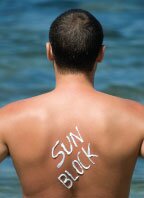
The Skinny on Skin Cancer
 |
Probably because of our cooler and often cloudier climate – especially on weekends! – Canadians don’t pay as much attention to skin cancers as we should. But skin cancer accounts for about half of all cancer diagnoses. Most are relatively benign and can be easily treated with surgery, but some can progress to become dangerous. The most lethal form is melanoma, which accounts for about 4% of all skin cancers, but almost 80% of all deaths. Melanoma is a cancer of younger people and can start in childhood and adolescence. UV rays from the sun or artificial light sources can also cause eye problems such as cataracts. The number of melanoma cases is increasing and this is expected to continue over the next twenty years. The financial burden in Canada of this disease was calculated at $532 million in 2004, with 88% being indirect costs, the vast majority of which were premature deaths. PreventionBased on a successful public health prevention strategy from Australia, researchers have estimated about 2,500 Canadian deaths could be avoided between 2004 and 2031. The program would have an average annual cost of about $10 million, but it could save about $2.1 billion in direct (physician and hospital care) and indirect (premature death and disability) costs over the study’s 28 year projection. Most of the money saved – almost $8 for each dollar spent on prevention – would be indirect and affect people of working age. The BC Cancer Agency has melanoma data from 2007 in very broad twenty-year age bands that indicate 47% of these cases are diagnosed, and 37% of deaths occur, during working years, ages 20 to 59. Those figures compare to 30% of all cancer diagnoses and 17% of all cancer deaths. Melanoma can be considered a young person’s cancer, and therefore important to employers. Hats and good quality sunglasses with UVA and UVB protection should be worn outside. To properly protect, clothing should fit loosely, be dry, and be tightly woven. Use a sunscreen with an SPF (Sun Protection Factor) of at least 15, and apply it regularly. Children are particularly vulnerable, especially in their first year or two, and even a sun tan is harmful for toddlers. In fact, all tans can be considered ‘bad’ since they are a defensive reaction to exposure to UVA and UVB rays. Risk FactorsSkin cancers have many potential causes. People who regularly work, play or exercise in the sun are at greater risk, but some people develop skin cancer without any of these risk factors:
There is strong evidence that artificial tanning beds significantly increase the risk for more serious types of skin cancer. Cancer Care Ontario recommends that tanning equipment should never be used. After a review of the scientific literature, in 2009 a unit of the World Health Organization declared that tanning devices are "carcinogenic to humans". Treatment OptionsTreatment for skin cancers, as with other cancers, varies by mode (surgery, radiation and chemotherapy), stage, or degree of progression (0 to 4), and grade (degree of abnormality). Treatment with drugs – either intravenous or pill form – is relatively rare for all types of skin cancer. Given the high and increasing incidence, employer exposure to this cancer may be measured in terms of productivity impact – physical and emotional – counter-balanced by the degree the workplace (organization, management, union, and work unit) is supportive.
While skin cancers account for so many cancer diagnoses, only a small percent are commonly lethal. As with all cancers, prevention strategies can be very effective, and early detection will save lives. Particularly in outside work with regular sun exposure, employers can play an important role in education and in reinforcing safe sun practices.
Sources: (1) Canadian Cancer Society (www.cancer.ca); (2) Save Your Skin Foundation (www.saveyourskin.ca); (3) Cancer Care Ontario, 2011. Cancer Fact: Cost of skin cancer in Ontario will exceed $344 million in 2011. Available at: www.cancercare.on.ca/cancerfacts/; (4) Canadian Partnership Against Cancer, 2010. The Economic Burden of Skin Cancer in Canada: Current and Projected. Available at: www.partnershipagainstcancer.ca/wp-content/uploads/Economic-Burden-of-Skin-Cancer-in-Canada-Report-Final1.pdf. (5) The United States Food and Drug Administration. Indoor Tanning: The Risks of Ultraviolet Rays, available at: http://www.fda.gov/forconsumers/consumerupdates/ucm186687.htm. |
